Punjab State Board PSEB 6th Class Maths Book Solutions Chapter 10 Practical Geometry Ex 10.4 Textbook Exercise Questions and Answers.
PSEB Solutions for Class 6 Maths Chapter 10 Practical Geometry Ex 10.4
1. Draw a circle of the following radius:
Question (i)
3.5 cm
Solution:
Steps of construction.
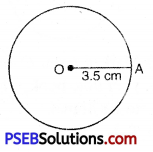
1. Mark a point O on the page of your note book, where a circle is to be drawn.
2. Take compasses fixed with sharp pencil and measure OA = 3.5 cm using a scale.
3. Without changing the opening of the compasses, keep the needle at point O and draw a complete arc by holding the compasses from its knob, we get the required circle.
![]()
Question (ii)
4 cm
Solution:
Steps of construction.
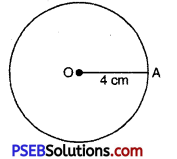
1. Mark a point O on the page of your note book, where a circle is to be drawn.
2. Take compasses fixed with sharp pencil and measure OA = 4 cm using a scale.
3. Without changing the opening of the compasses, keep the needle at point O and draw a complete arc by holding the compasses from its knob.
Question (iii)
2.8 cm
Solution:
Steps of construction
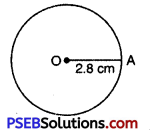
1. Mark a point O on the page of your note book, where a circle is to be drawn.
2. Take compasses fixed with sharp pencil and measures OA = 2.8 cm using a scale.
3. Without changing the opening of the compasses, keep the needle at point O and draw a complete arc by holding the compasses from its knob, we get the required circle.
![]()
Question (iv)
4.7 cm
Solution:
Steps of construction
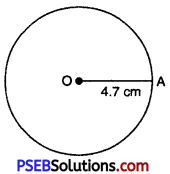
1. Mark a point O on the page of your note book.
2. Take compasses fixed with sharp pencil and measures OA = 4.7 cm using a scale.
3. Without changing the opening of the compasses, keep the needle at point O and draw a complete arc by holding the compasses from its knob, we get the required circle.
Question (v)
5.2 cm.
Solution:
Steps of construction
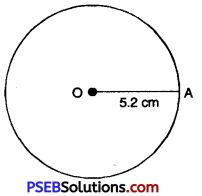
1. Mark a point O on the page of your note book.
2. Take compasses fixed with sharp pencil and measures OA = 5.2 cm using a scale.
3. Without changing the opening of the compasses, keep the needle at point O and draw a complete arc by holding the compasses from its knob, we get the required circle.
![]()
2. Draw a circle of diameter 6 cm.
Solution:
Steps of construction
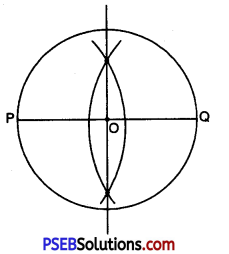
1. Draw a line segment PQ = 6 cm.
2. Draw the perpendicular bisector of PQ intersecting PQ at O.
3. With O as centre and radius = OQ = 3 cm (= OP), draw a circle.
The circle thus drawn is the required circle.
3. With the same centre O, draw two concentric circles of radii 3.2 cm and 4.5 cm.
Solution:
Steps of Construction
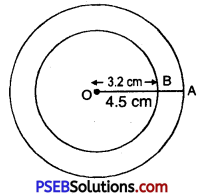
1. Mark a point O on the page of your note book, where a circle is drawn.
2. Take compasses fixed with sharp pencil measuring OA = 4.5 cm using scale.
3. Without changing the opening of the compasses, keep the needle at point O and draw complete arc by holding the compasses from its knob.
After completing one round, we get circle I.
4. Again with the same centre O and new radius = 3.2 cm draw another circle II following the same step 3.
![]()
4. Draw a circle of radius 4.2 cm with centre at O. Mark three points A, B and C such that point A is on the circle, B is in the interior and C is in the exterior of the circle.
Solution:
Steps of Construction

1. Mark a point O on the page of your note book, where a circle is to be drawn
2. Take compasses fixed with sharp pencil and measure OA = 4.2 cm using scale (∴ A is on the circle).
3. Without changing the opening of the compasses, keep the needle at point O and draw complete arc by rotating the compasses from the knob. After completing one round, we get required circle.
4. Mark point B in the interior of the circle and point C in the exterior of the circle.
5. Draw a circle of radius 3 cm and draw any chord. Draw the perpendicular bisector of the chord. Does the perpendicular bisector passes through the centre?
Solution:
Steps of Construction.

1. Draw a circle with C as centre and radius 3 cm.
2. Draw AB the chord of the circle.
3. Draw PQ the perpendicular bisector of chord AB.
4. We see that the perpendicular bisector of chord AB passes through the centre C of the circle.
